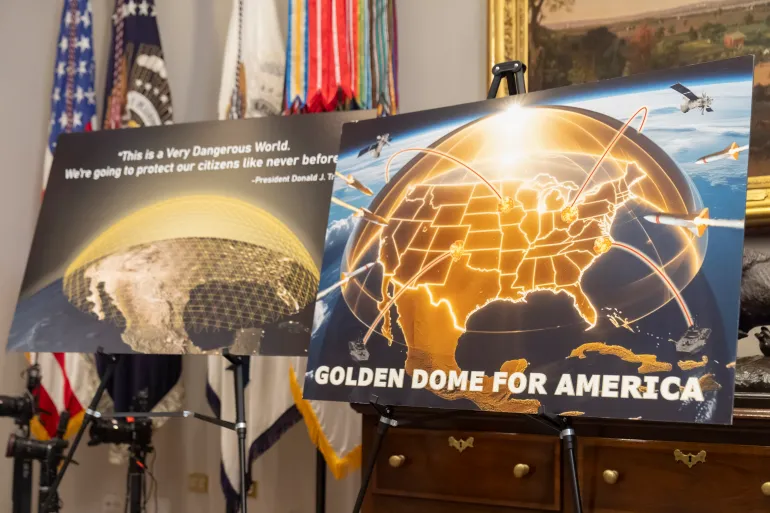Trump Announces $175 Billion Golden Dome Missile Defense Shield Led by Space Force General
President Donald Trump has officially unveiled the Golden Dome Missile Defense Shield, a massive $175 billion initiative aimed at protecting the United States from potential missile attacks by China, Russia, and other adversaries. The ambitious space-based system, inspired by Israel’s Iron Dome and Reagan’s “Star Wars” initiative, will be led by U.S. Space Force General Michael Guetlein.
What Is the Golden Dome Missile Defense Program?
The Golden Dome is a next-generation missile defense program involving hundreds of satellites designed to detect, track, and intercept enemy missiles in real time. These satellites will work in coordination with advanced software and autonomous systems, offering the United States a strategic edge in space-based defense.
“Golden Dome will protect our homeland,” said President Trump at a press conference. “Even Canada wants to join the program.”
Canadian Prime Minister Mark Carney confirmed discussions are underway to integrate the Golden Dome with NORAD and strengthen bilateral security ties.
Program Budget: $175 billion (projected over 10 years)
Leadership: General Michael Guetlein, U.S. Space Force
Goal: Full operational capability by January 2029
Defense Partners: Potential involvement from SpaceX, Palantir, Anduril, L3Harris, Lockheed Martin, and RTX Corporation
Benefiting States: Alaska, Florida, Georgia, and Indiana
Industry Players and Controversy
Major defense and tech firms are expected to compete for contracts to build components of the Golden Dome system. Likely contenders include:
SpaceX (satellite deployment)
Palantir Technologies (AI and analytics)
Anduril Industries (autonomous systems)
Lockheed Martin, L3Harris, and RTX Corp (legacy defense hardware)
However, Democratic lawmakers have raised ethical concerns regarding the involvement of Elon Musk’s SpaceX, citing potential conflicts of interest due to Musk’s close ties with Trump.
“This program is more Silicon Valley than traditional defense,” said Senator Kevin Cramer (R-ND). “It opens the door for new tech players to participate and innovate.”
States to Gain Economic Boost
The Golden Dome will have a national footprint, with facilities and resources spread across key states:
Alaska: Strategic defense deployment
Florida: Satellite launch operations
Georgia: Support and logistics
Indiana: L3Harris manufacturing center for advanced tracking systems
L3Harris has already invested $150 million in its Fort Wayne facility to produce satellites capable of tracking hypersonic weapons—a technology expected to be core to the Golden Dome.
Funding and Political Challenges
While initial support for the program is strong, its funding hinges on the success of a $150 billion defense package currently tied to a reconciliation bill in Congress. Lawmakers have proposed $25 billion in initial funding, but political hurdles could delay or derail the entire initiative.
“If reconciliation doesn’t pass, the funding may collapse,” warned a defense executive familiar with the program.
Additionally, the Congressional Budget Office (CBO) has projected total costs could reach $831 billion over 20 years, far above the current estimate.
Final Thoughts
The Golden Dome represents a major pivot in U.S. military strategy, fusing cutting-edge space technology with traditional defense infrastructure. While ambitious, its success will depend on bipartisan support, transparent procurement, and the integration of both new and legacy defense contractors.
Golden Dome missile defense
Trump missile shield 2025
U.S. space-based missile defense
Space Force Michael Guetlein
SpaceX defense contract
Palantir missile tracking
